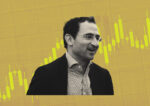Trending
Cutthroat competition drives real estate bigwigs to get crafty

Stay on your toes: That’s the message from the “titans” of New York City real estate. Major infrastructural changes are afoot, thanks to transformative projects like Hudson Yards, Atlantic Yards and the World Trade Center, and with the lending landscape fundamentally changed since the recession and a spike in interest from international investors fueling competition, it’s all the more important to get creative with project partnerships.
The “titans” were assembled at the Pierre Hotel to speak at the annual New York University Schack Capital Markets conference. Panelists included Jay Cross, president of Related Hudson Yards; MaryAnne Gilmartin, CEO of Forest City Ratner; Larry Silverstein, CEO of Silverstein Properties; Bill Rudin, CEO of Rudin Management; William Mack, chairman of Mack Real Estate Group; Marc Holliday, CEO of SL Green Realty; and Scott Rechler, CEO of RXR Realty.
“On the acquiring side, how can we maintain our competitive advantage in buying properties?,” asked Paul Galiano of Tishman Speyer. “In some major markets, there’s so much capital that it’s driving prices to a level where it’s hard to be competitive. Sovereign wealth funds are outgrowing their own borders. They want to buy in London, they want to buy in New York.”
Indeed, some major U.S. players, such as Colony Capital, are wishing for an uptick in interest rates in order to drive out some of the competition, they said. “That would actually be a better environment for us,” said Colony President Richard Saltzman.
For those with mammoth new projects in the works, such as Related with Hudson Yards and Forest City Ratner with Atlantic Yards, principals are dealing with new issues in the lending sector.
Related, for instance, had to rethink its entire strategy for financing Hudson Yards thanks to instability in the lending market following the credit crisis, Cross said. Instead of raising a $2 billion fund to finance the entire project, the company borrowed for individual buildings, and even made the decision to have prospective tenants for the office properties, such as retailer Coach, contribute equity. Banks simply could not afford to hold such mammoth loans on their books following the downturn, he said.
“Even Jon Mechanic thought it was complicated,” Cross joked, referring to Jonathan Mechanic, a noted real estate attorney at Fried Frank.
In an unusual move for the company, Forest City also recently raised capital by selling a 70 percent stake in Atlantic Yards to Chinese developer Greenland.
“As we looked into the world post-recession, our business strategy changed,” Gilmartin said. “We’ve become a company that enjoys partnerships.”
Gilmartin said partnerships allow Forest City to demonstrate to lenders the value it is creating via its projects. “If you don’t sell, it’s hard to point to that,” she said.
In another recent deal to bring on a partner, Forest City Ratner sold a 49 percent stake in its rental tower New York by Gehry at 8 Spruce Street to pension fund and real estate heavy TIAA-CREF for $250 million in December.
A year after Hurricane Sandy, the panelists weighed in on how New York fared.
“We have come back from Sandy,” Rudin said, noting that he had predicted a full recovery when he was on CNBC last year. “When I went back on recently, I wish they had run the tape, because I was right.”
Silverstein, whose World Trade Center site was inundated with about 200 million gallons of water, said that, “nothing seems to daunt New Yorkers,” while Holliday said though the storm was a wake-up call, in the past it could have been a “100-year-event,” a nod to how quickly landlords regrouped after the storm and reinvested in the resiliency of their buildings.
The panelists also discussed the Midtown East rezoning proposal, which was approved by the City Planning Commission at the end of September. Holliday, whose SL Green would benefit tremendously from the rezoning, said that there was a need to allow certain sites – those over 25,000 square feet with avenue frontage – to build up to twice the current floor-to-area ratio permitted in the area, but “consistent with what is being built throughout the rest of the world today.”
“It’s certainly in the city’s interest to make sure that Grand Central remains vital while the other development forces such as Hudson Yards and the Far West Side are rising,” Holliday added.
Silverstein, sporting his trademark orange tie, piped in with a single statistic: “Sixty percent of New York office stock is over 50 years of age.”
What makes the Midtown East plan especially notable, Rudin said, was that no residents would be displaced, in contrast to other recent rezonings.
“This will be one of Bloomberg’s legacies if we can get it through,” he said.
Turning to the future, Rechler said that he expected Lower Manhattan to come into its own. Right now, “it’s going through an awkward stage with a lot of ongoing development as well as the construction of the [Fulton Street] transportation hub.”
Rudin said that key issues to look out for next year were dysfunction in Washington, as well as the expiration in December 2014 of the Terrorism Risk Insurance Act, which provides required terrorism insurance for construction projects in the city. If the act isn’t renewed, Rudin said, “we will have a really tough time.”
Mack echoed the idea expressed throughout the day that the recovery, though real, was “fragile, and somewhat dependent on low interest rates.” But, he quipped, “if we all keep wishing, everything will turn out great.”




